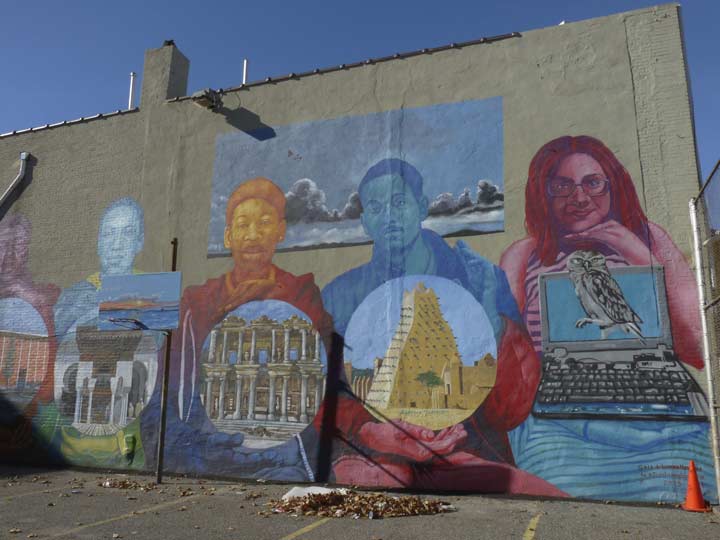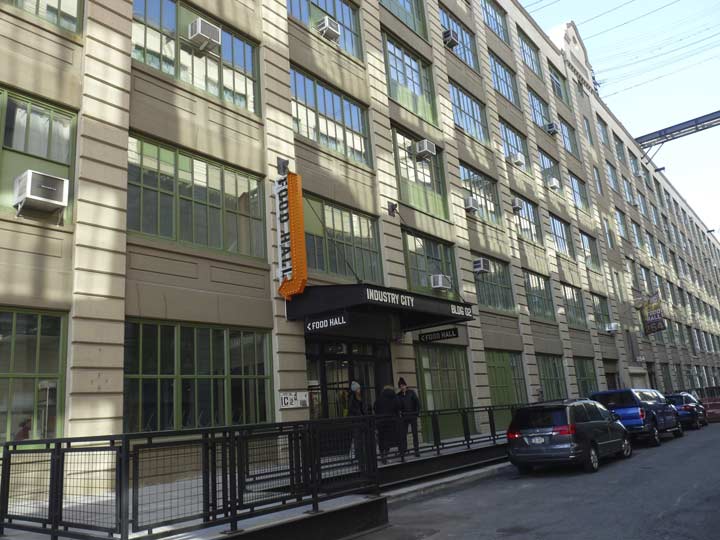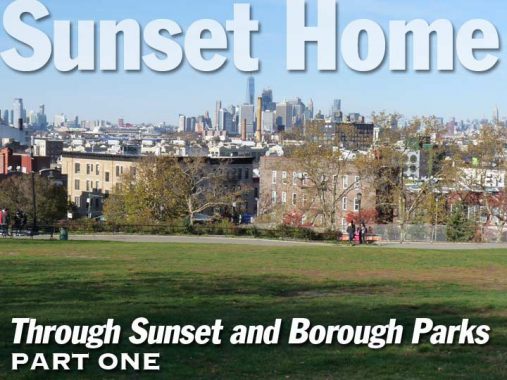Continued from the FNY page Before the Sunset
Not long ago I marched down 4th Avenue and 39th Street in a neighborhood called Greenwood Heights, after its position just west of Green-Wood Cemetery. A couple of months before that, though, I walked from near the waterfront east through Sunset Park itself, further east into Borough Park and ended up around sunset in Kensington. Though I’m quite familiar with all three areas, they have gotten somewhat less coverage in FNY than other areas, largely because they’re “bedroom” communities without a lot going on — at least till lately. Gentrifiers have had their sights set on Sunset Park of late; and Mayor de Blasio has proposed NYC’s first light rail line in decades, the Brooklyn-Queens Connector, which would originate in Sunset Park and run along Brooklyn and Queens’ waterfront neighborhoods northeast as far as Astoria.
GOOGLE MAP: SUNSET PARK to BOROUGH PARK

This relatively new mural appears in the parking lot behind PS 371 at 4th Avenue and 36th Street. Are those supposed to be actual buildings? I can’t identify them. Let me know at kevinjudewalsh@gmail.com,

Block after block of monolithic stone-clad buildings between 2nd Ave and 3rd Avenue from 30th to 36th Streets were constructed by architect William Higginson in the first 3 decades of the 20th Century for industrialist Irving T. Bush. There are 15 lofts in total, each 6 to 8 stories in height, fully 200 acres of land given to vast warehouses and manufacturing lofts. What was once called Bush Terminal, now called Industry City, had a waterfront railroad and 18 deep water piers.
Today Industry City is becoming a beehive of activity in the telecommunications field, as many of its buildings are being converted by Industry City Associates into broadband services providers, providing digital broadcasts over the internet and high-speed internet. Those who work at the site also have a variety of amenities such as a food court, athletic club, bike parking and shopping that are also open to the public to certain degree.
Intrigued by the prospect of a “Food Hall” (I hadn’t had lunch) I entered one of the 36th Street buildings to find it still under construction– or else vendors aren’t there on Saturday.
In an adjacent building, several pop up shops in a flea market like setting were opening for the afternoon.
The streets between Industry City buildings are not illuminated with Department of Transportation lampposts and they have retained their original Belgian block paving.
Although most of it is no longer in use, tracks once used by the South Brooklyn Railway still are in evidence on 2nd Avenue between 32nd and 42nd Streets.
These are the only remaining active tracks of the SBR, connecting the waterfront docks with the West End subway line. Until the late 1970s, the SBR had proprietary tracks running down the middle of McDonald Avenue to the Coney Island Yards, but freight service was then switched to the West End El (now serving the D train) and the old surface tracks were finally removed in the 1980s.
The SBR has a rich history. According to NYC transit historian/hockey maven Stan Fischler in his subway history Uptown, Downtown:
–It was once attempted to haul a dead whale along the SBK to the Coney Island Yards, where it would be trucked to the Coney Island Aquarium. The whale had been killed and embalmed in the North Atlantic and shipped to the SBK yard. The whale was strapped onto a flatcar and a loco began to haul it along the SBK.
The whale got as far as the tunnel south of 4th Avenue, but wouldn’t fit in the tunnel. I suppose they then had to “ship” it to the Aquarium.
–The SBK also hauled a downed Army plane that crashed in Pennsylvania to the Coney Yards and then the pieces were trucked over to Floyd Bennett Field on Flatbush Avenue for an inquiry.
–The SBK did a lot of business with the many Brooklyn breweries that flourished pre-Prohibition. It also did a good business hauling wine grapes for Brooklynites who flouted the law during Prohibition.
The South Brooklyn arose from one of the many different passenger and freight railroads that ran in Brooklyn before subway service arrived in the early 20th Century, the Prospect Park and Coney Island Railroad, which for much of its route ran along Gravesend (now McDonald) Avenue.
At 2nd Avenue and 39th Street, some businesses just seem to go together.
Even in the most industrial or out of the way areas imaginable, there are mixed use residential buildings like this one at the corner of 2nd Avenue and 42nd Street.
A brick building on 42nd Street between 2nd and 3rd Avenues bears the logo of a former industry located in the building.
Thomas Shipley, Inc. purchased the York Oil Burner Company in 1938, buying out Hoffman and Kraber. The York Oil Burner Company continued to operate as a subsidiary of Thomas Shipley, Inc. until 1943 when the name was changed to York-Shipley, Inc. York-Shipley, Inc. manufactured, installed, fueled and serviced oil furnaces and boilers. The company also provided automotive fuel and supply services. Today the business operates as York-Shipley Global a division of AESYS Technologies.
At the corner of 3rd Avenue and 40th Street, in the shadow of the Gowanus Expressway, is Frankel’s Bootery, a Sunset Park institution going back to 1890 when Adolph Frankel founded the store on the opposite side of 3rd Avenue. In the early 1960s all buildings on the east side of 3rd Avenue were razed to make way for the expressway, which originally was placed on infrastructure left over from the Brooklyn 5th Avenue El, which ran on 3rd in these parts. Frankel moved across the street and the shop is still run by his descendants. Customer reviews vary wildly.
These attached brick residences, some with original stoop railings, are unheralded and not in any of the architectural guidebooks, but in their own genre, they are masterpieces. 41st Street between 3rd and 4th Avenues.
There are a number of very interesting buildings, architecturally speaking, clustered at 4th Avenue and 43rd Street. The first is the incredibly tall, 200-foot high campanile of St. Michael’s Church, a parish founded in 1870; the current church, designed by Raymond Almirall, was dedicated in 1905. That year, it was the tallest building in Brooklyn and was later succeeded by the Williamsburg Bank tower now called One Hanson in 1928 (which itself has been succeeded a couple of times since).
Almirall designed a similar, but much shorter, structure in Queens’ Calvary Cemetery in 1895, the cemetery chapel. With their “beehive” towers, both buildings resembles the Cathedral of the Sacred Heart in Paris. The Calvary chapel also served as a burial crypt for NYC’s parish priests.
Though the adjacent St. Michael’s parish school was closed in 2005, the building still hosts PS 522. The chiseled in identifier still appears on the facade, along with an incredible “AE” ligature. The combo “ae” doesn’t appear much in English, mostly in Latin loanwords, but it’s survived over the centuries in the given names Michael and Raphael, both Archangels in the Christian canon. Rarer still is the printed ligature for capital AE; you see if often in the lowercase combo. I’ve only ever seen it in print for the Latin name AEgyptus.
Old ’68’
Even though I did include it in the ForgottenBook in 2006, I have never been able to get really good shots of the former 68th (originally 18th Precinct of the Brooklyn police department) NYPD Precinct and Stables on 4th avenue and 43rd until now. There had been to much foliage, or the sun angle wasn’t right. I was able to nab some better pictures this time around.
The building was an early addition to the Sunset Park scene. The Romanesque revival buildings designed by Emile M. Gruwe were completed in 1886, even predating Sunset Park itself and the Bush Terminal buildings along the waterfront, which began to appear in 1890. After Brooklyn was annexed to NYC in 1898 this building became an NYPD precinct and went from the 18th to 43rd to 143rd to finally the 68th Precinct. Gruwe also designed the nearly identical 75th Precinct building, also in disrepair, on Liberty and Miller Avenues in East New York.
The building has been vacant since the 68th merged with another precinct and moved into a new building further north on 4th Avenue and 29th Street. There have been plans to convert the old 68th to a school for decades — a 1986 sign touting one such project can still be seen on the fence outside the entrance — but none seem to have gained traction. Another plan was floated in 2016.
Sunset Park’s architectural riches are also manifested across 4th Avenue from the 68th Precinct and St. Michael’s Church at 4201, where stands the former Sunset Park Court House or Magistrates’ Court, a relatively recent addition from 1931 (Mortimer D. Metcalfe, arch.). It was one of four ‘regional’ courthouses that handled local cases before courts were centralized on Brooklyn’s Legal Row on Cadman Plaza West in 1962. Defendants processed in the 68th were arraigned here. Grand Ionic-columned entrances appear on both the 42nd and 43rd Street sides.
After the court moved out in 1962 the building was used for decades as offices by Community Board 7 and later as a police training venue. After several years of disrepair, it was renovated in 1996. Montrose Morris has more in Brownstoner.
Meanwhile, a block away on 41st and 4th, here’s what was originally PS, now Middle School 136, a magnificent school building designed in 1902 by prolific schools architect C.B.J. Snyder. For the past couple of decades it has been the Charles O. Dewey School. Dewey (1854-1914) was a principal of the school in its early days.
Though neighboring Park Slope is known for its brownstones, Sunset Park and Bay Ridge feature row after row of handsome attached brickface homes such as these on 41st Street. Neighboring blocks look much the same, with trees overhanging the street providing shade during the block during the blazing summer months under the “thermonuclear eye of God.”
#450 41st Street has an intact original double door.
5th Avenue, like 3rd and 4th Avenue, runs continuously from downtown Brooklyn to Bay Ridge; these are the only three numbered Brooklyn Avenues to claim that honor. There are 28 such avenues in all.
La Gloria Novelties, a botanica selling religious artifacts and other hexerei on 5th avenue between 41st and 42nd Streets, may have been here when I was commuting via the B63 bus to high school and college in the 1970s.
Time to climb the steps and enter Sunset Park — but that will wait till Part 2, in which we will also explore Little Finlandia.
“Comment…as you see fit.” kevinjudewalsh@gmail.com
2/26/17
